NMR and MD Analysis of the Bonding Interaction of Vancomycin with Muramyl Pentapeptide
Abstract
1. Introduction
2. Results and Discussion
2.1. NMR Study
2.2. MD Study
3. Materials and Methods
3.1. NMR Measurements
3.2. MD Simulations
4. Conclusions
Author Contributions
Funding
Institutional Review Board Statement
Informed Consent Statement
Data Availability Statement
Acknowledgments
Conflicts of Interest
References
- Fridkin, S.K.; Hageman, J.; McDougal, L.K.; Mohammed, J.; Jarvis, W.R.; Perl, T.M.; Tenover, F.C.; Vancomycin-Intermediate Staphylococcus aureus Epidemiology Study Group. Epidemiological and Microbiological Characterization of Infections Caused byStaphylococcus aureuswith Reduced Susceptibility to Vancomycin, United States, 1997–2001. Clin. Infect. Dis. 2003, 36, 429–439. [Google Scholar] [CrossRef]
- Hiramatsu, K. Vancomycin-resistant Staphylococcus aureus: A new model of antibiotic resistance. Lancet Infect. Dis. 2001, 1, 147–155. [Google Scholar] [CrossRef]
- Howden, B.P.; Davies, J.K.; Johnson, P.D.R.; Stinear, T.P.; Grayson, M.L. Reduced Vancomycin Susceptibility in Staphylococcus aureus, Including Vancomycin-Intermediate and Heterogeneous Vancomycin-Intermediate Strains: Resistance Mechanisms, Laboratory Detection, and Clinical Implications. Clin. Microbiol. Rev. 2010, 23, 99–139. [Google Scholar] [CrossRef]
- Biavasco, F.; Vignaroli, C.; Varaldo, P.E. Glycopeptide Resistance in Coagulase-Negative Staphylococci. Eur. J. Clin. Microbiol. Infect. Dis. 2000, 19, 403–417. [Google Scholar] [CrossRef]
- Strahilevitz, J.; Rubinstein, E. Novel agents for resistant Gram-positive infections—a review. Int. J. Infect. Dis. 2002, 6, S38–S46. [Google Scholar] [CrossRef][Green Version]
- Perkins, H.R. Specificity of combination between mucopeptide precursors and vancomycin or ristocetin. Biochem. J. 1969, 111, 195–205. [Google Scholar] [CrossRef]
- Barna, J.C.J.; Williams, D.H. The structure and mode of action of glycopeptide antibiotics of the vancomycin group. Annu. Rev. Microbiol. 1984, 38, 339–357. [Google Scholar] [CrossRef]
- Bugg, T.D.H.; Wright, G.; Dutka-Malen, S.; Arthur, M.; Courvalin, P.; Walsh, C.T. Molecular basis for vancomycin resistance in Enterococcus faecium BM4147: Biosynthesis of a depsipeptide peptidoglycan precursor by vancomycin resistance proteins VanH and VanA. Biochemistry 1991, 30, 10408–10415. [Google Scholar] [CrossRef]
- Arthur, M.; Courvalin, P. Genetics and mechanisms of glycopeptide resistance in enterococci. Antimicrob. Agents Chemother. 1993, 37, 1563–1571. [Google Scholar] [CrossRef]
- Walsh, C.T. Vancomycin Resistance: Decoding the Molecular Logic. Science 1993, 261, 308–309. [Google Scholar] [CrossRef]
- Ge, M.; Chen, Z.; Russell, H.; Onishi, H.R.; Kohler, J.; Silver, L.L.; Kerns, R.; Fukuzawa, S.; Thompson, C.; Kahne, D. Vancomycin Derivatives That Inhibit Peptidoglycan Biosynthesis Without Binding d -Ala- d -Ala. Science 1999, 284, 507–511. [Google Scholar] [CrossRef] [PubMed]
- Samaszko-Fiertek, J.; Szulc, M.; Dmochowska, B.; Jaśkiewicz, M.; Kamysz, W.; Ślusarz, R.; Madaj, J. Influence of Carbohydrate Residues on Antibacterial Activity of Vancomycin. Lett. Org. Chem. 2020, 17, 287–293. [Google Scholar] [CrossRef]
- Jordan, D.C.; Inniss, W.E. Selective Inhibition of Ribonucleic Acid Synthesis in Staphylococcus aureus by Vancomycin. Nature 1959, 184, 1894–1895. [Google Scholar] [CrossRef]
- Sheldrick, G.M.; Jones, P.G.; Kennard, O.; Williams, D.H.; Smith, G.A. Structure of vancomycin and its complex with acetyl-D-alanyl-D-alanine. Nature 1978, 271, 223–225. [Google Scholar] [CrossRef]
- Williams, D.H.; Williamson, M.P.; Butcher, D.W.; Hammond, S.J. Detailed binding sites of the antibiotics vancomycin and ristocetin A: Determination of intermolecular distances in antibiotic/substrate complexes by use of the time-dependent NOE. J. Am. Chem. Soc. 1983, 105, 1332–1339. [Google Scholar] [CrossRef]
- Rao, J.; Whitesides, G.M. Tight Binding of a Dimeric Derivative of Vancomycin with Dimeric l-Lys-d-Ala-d-Ala. J. Am. Chem. Soc. 1997, 119, 10286–10290. [Google Scholar] [CrossRef]
- Szulc, M.; Samaszko-Fiertek, J.; Slusarz, R.; Kowalska, K.; Sikorski, A.; Madaj, J. Solid phase synthesis of two muramyl pentapeptide derivatives. J. Carbohydr. Chem. 2016, 35, 161–171. [Google Scholar] [CrossRef]
- Williams, D.H.; Kalman, J.R. Structural and mode of action studies on the antibiotic vancomycin. Evidence from 270-MHz proton magnetic resonance. J. Am. Chem. Soc. 1977, 99, 2768–2774. [Google Scholar] [CrossRef]
- Williamson, M.P.; Williams, D.H. Structure revision of the antibiotic vancomycin. Use of nuclear Overhauser effect difference spectroscopy. J. Am. Chem. Soc. 1981, 103, 6580–6585. [Google Scholar] [CrossRef]
- Pearce, C.M.; Williams, D.H. Complete assignment of the 13C NMR spectrum of vancomycin. J. Chem. Soc. Perkin Trans. 2 1995, 153–157. [Google Scholar] [CrossRef]
- Tian, Y.; Chong, X.; Yao, S.; Xu, M. Spectral Data Analysis and Identification of Vancomycin Hydrochloride. Front. Chem. 2021, 9, 782. [Google Scholar] [CrossRef] [PubMed]
- Sujatha, S.; Praharaj, I. Glycopeptide Resistance in Gram-Positive Cocci: A Review. Interdiscip. Perspect. Infect. Dis. 2012, 2012, 1–10. [Google Scholar] [CrossRef]
- Hibbert, F.; Emsley, J. Hydrogen Bonding and Chemical Reactivity. In Advances in Physical Organic Chemistry; Bethell, D., Ed.; Academic Press: San Diego, CA, USA, 1990; Volume 26, pp. 255–379. [Google Scholar]
- Yao, N.-H.; He, W.-Y.; Lam, K.S.; Liu, G. Conformational Studies of Resin-Bound Vancomycin and the Complex of Vancomycin and Ac2-l-Lys-d-Ala-d-Ala. J. Comb. Chem. 2004, 7, 123–129. [Google Scholar] [CrossRef]
- Ślusarz, R.; Szulc, M.; Madaj, J. Molecular modeling of Gram-positive bacteria peptidoglycan layer, selected glycopeptide antibiotics and vancomycin derivatives modified with sugar moieties. Carbohydr. Res. 2014, 389, 154–164. [Google Scholar] [CrossRef] [PubMed]
- Kannan, R.; Harris, C.M.; Harris, T.M.; Waltho, J.P.; Skelton, N.J.; Williams, D.H. Function of the amino sugar and N-terminal amino acid of the antibiotic vancomycin in its complexation with cell wall peptides. J. Am. Chem. Soc. 1988, 110, 2946–2953. [Google Scholar] [CrossRef]
- Bax, A.; Davis, D.G. MLEV-17-based two-dimensional homonuclear magnetization transfer spectroscopy. J. Magn. Reson. (1969) 1985, 65, 355–360. [Google Scholar] [CrossRef]
- Jeener, J.; Meier, B.; Bachmann, P.; Ernst, R.R. Investigation of exchange processes by two-dimensional NMR spectroscopy. J. Chem. Phys. 1979, 71, 4546–4553. [Google Scholar] [CrossRef]
- Macura, S.; Ernst, R.R. Elucidation of cross relaxation in liquids by two-dimensional N.M.R. spectroscopy. Mol. Phys. 1980, 41, 95–117. [Google Scholar] [CrossRef]
- Bax, A.; Davis, D.G. Practical aspects of two-dimensional transverse NOE spectroscopy. J. Magn. Reson. (1969) 1985, 63, 207–213. [Google Scholar] [CrossRef]
- Palmer, A.G.; Cavanagh, J.; Wright, P.; Rance, M. Sensitivity improvement in proton-detected two-dimensional heteronuclear correlation NMR spectroscopy. J. Magn. Reson. (1969) 1991, 93, 151–170. [Google Scholar] [CrossRef]
- Kay, L.; Keifer, P.; Saarinen, T. Pure absorption gradient enhanced heteronuclear single quantum correlation spectroscopy with improved sensitivity. J. Am. Chem. Soc. 1992, 114, 10663–10665. [Google Scholar] [CrossRef]
- Schleucher, J.; Schwendinger, M.; Sattler, M.; Schmidt, P.; Schedletzky, O.; Glaser, S.; Griesinger, C. A general enhancement scheme in heteronuclear multidimensional NMR employing pulsed field gradients. J. Biomol. NMR 1994, 4, 301–306. [Google Scholar] [CrossRef]
- Fukushi, E. Advanced NMR Approaches for a Detailed Structure Analysis of Natural Products. Biosci. Biotechnol. Biochem. 2006, 70, 1803–1812. [Google Scholar] [CrossRef][Green Version]
- Zwahlen, C.; Legault, P.; Vincent, S.J.F.; Greenblatt, J.; Konrat, R.; Kay, L.E. Methods for Measurement of Intermolecular NOEs by Multinuclear NMR Spectroscopy: Application to a Bacteriophage λ N-Peptide/boxB RNA Complex. J. Am. Chem. Soc. 1997, 119, 6711–6721. [Google Scholar] [CrossRef]
- Boyer, R.D.; Johnson, R.; Krishnamurthy, K. Compensation of refocusing inefficiency with synchronized inversion sweep (CRISIS) in multiplicity-edited HSQC. J. Magn. Reson. 2003, 165, 253–259. [Google Scholar] [CrossRef] [PubMed]
- Hwang, T.-L.; Shaka, A. Water Suppression That Works. Excitation Sculpting Using Arbitrary Wave-Forms and Pulsed-Field Gradients. J. Magn. Reson. Ser. A 1995, 112, 275–279. [Google Scholar] [CrossRef]
- Case, D.A.; Betz, R.M.; Cerutti, D.S.; Cheatham, I.T.E.; Darden, T.A.; Duke, R.E.; Giese, T.J.; Gohlke, H.; Goetz, A.W.; Homeyer, N.; et al. AMBER 16. University of California, San Francisco, CA, USA. 2016. Available online: https://ambermd.org/doc12/Amber16.pdf (accessed on 13 December 2021).
- Duan, Y.; Wu, C.; Chowdhury, S.; Lee, M.C.; Xiong, G.; Zhang, W.; Yang, R.; Cieplak, P.; Luo, R.; Lee, T.; et al. A point-charge force field for molecular mechanics simulations of proteins based on condensed-phase quantum mechanical calculations. J. Comput. Chem. 2003, 24, 1999–2012. [Google Scholar] [CrossRef]
- Lee, M.C.; Duan, Y. Distinguish protein decoys by Using a scoring function based on a new AMBER force field, short molecular dynamics simulations, and the generalized born solvent model. Proteins Struct. Funct. Bioinform. 2004, 55, 620–634. [Google Scholar] [CrossRef] [PubMed]
- Kirschner, K.N.; Yongye, A.B.; Tschampel, S.M.; González-Outeiriño, J.; Daniels, C.R.; Foley, B.L.; Woods, R.J. GLYCAM06: A generalizable biomolecular force field. Carbohydrates. J. Comput. Chem. 2008, 29, 622–655. [Google Scholar] [CrossRef] [PubMed]
- Foley, B.L.; Tessier, M.B.; Woods, R.J. Carbohydrate force fields. Wiley Interdiscip. Rev. Comput. Mol. Sci. 2011, 2, 652–697. [Google Scholar] [CrossRef]
- Price, D.J.; Brooks, C.L. A modified TIP3P water potential for simulation with Ewald summation. J. Chem. Phys. 2004, 121, 10096–10103. [Google Scholar] [CrossRef] [PubMed]
- Ryckaert, J.-P.; Ciccotti, G.; Berendsen, H.J.C. Numerical integration of the cartesian equations of motion of a system with constraints: Molecular dynamics of n-alkanes. J. Comput. Phys. 1977, 23, 327–341. [Google Scholar] [CrossRef]
- Berendsen, H.J.C.; Postma, J.P.M.; Van Gunsteren, W.F.; DiNola, A.; Haak, J.R. Molecular dynamics with coupling to an external bath. J. Chem. Phys. 1984, 81, 3684. [Google Scholar] [CrossRef]
- Ewald, P.P. Die Berechnung optischer und elektrostatischer Gitterpotentiale. Ann. der Phys. 1921, 369, 253–287. [Google Scholar] [CrossRef]
- Darden, T.; Perera, L.; Li, L.; Pedersen, L. New tricks for modelers from the crystallography toolkit: The particle mesh Ewald algorithm and its use in nucleic acid simulations. Structure 1999, 7, R55–R60. [Google Scholar] [CrossRef]
- Salomon-Ferrer, R.; Götz, A.W.; Poole, D.; Le Grand, S.; Walker, R.C. Routine Microsecond Molecular Dynamics Simulations with AMBER on GPUs. 2. Explicit Solvent Particle Mesh Ewald. J. Chem. Theory Comput. 2013, 9, 3878–3888. [Google Scholar] [CrossRef]
- Roe, D.R.; Cheatham, T.E., III. PTRAJ and CPPTRAJ: Software for Processing and Analysis of Molecular Dynamics Trajectory Data. J. Chem. Theory Comput. 2013, 9, 3084–3095. [Google Scholar] [CrossRef] [PubMed]
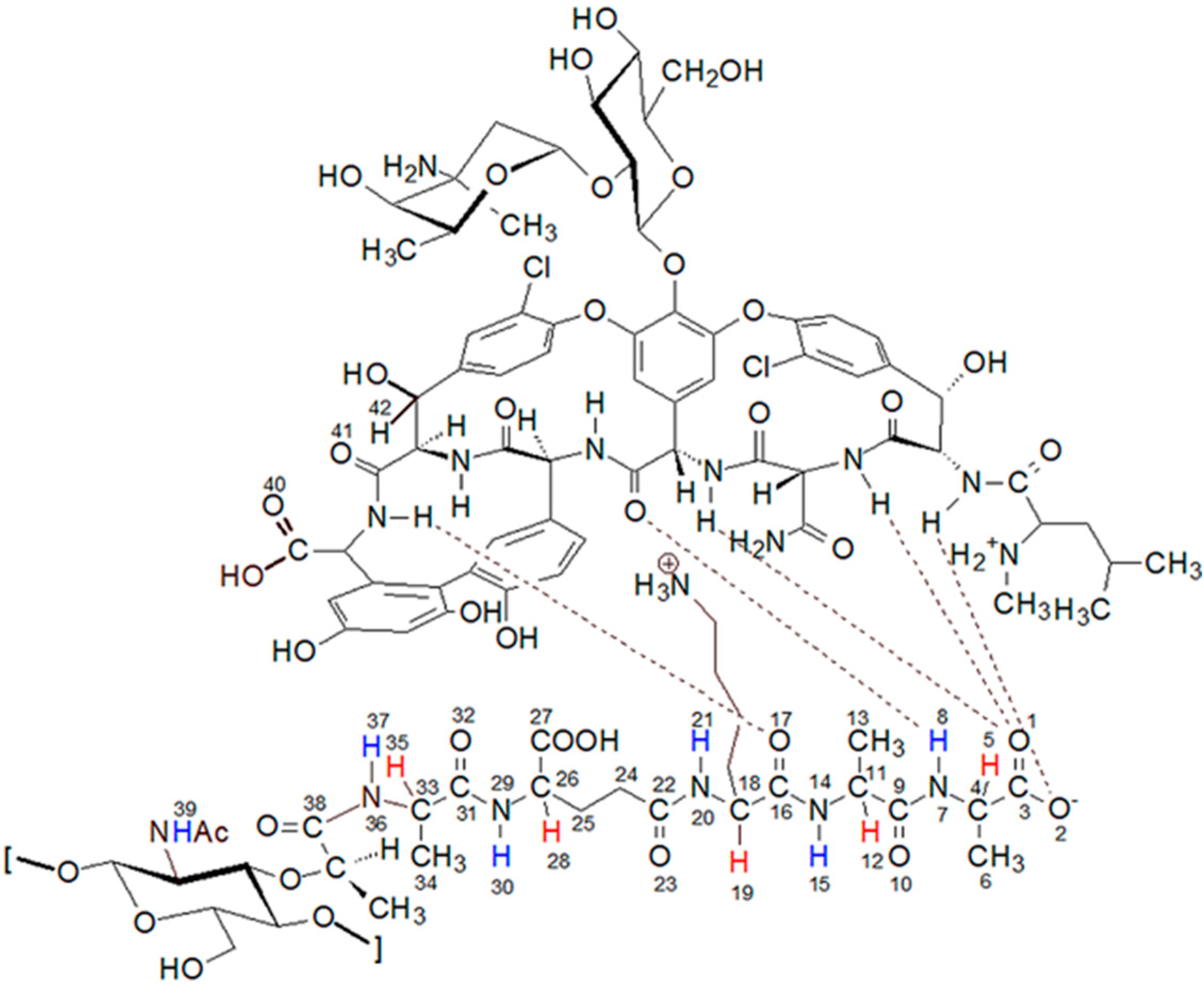
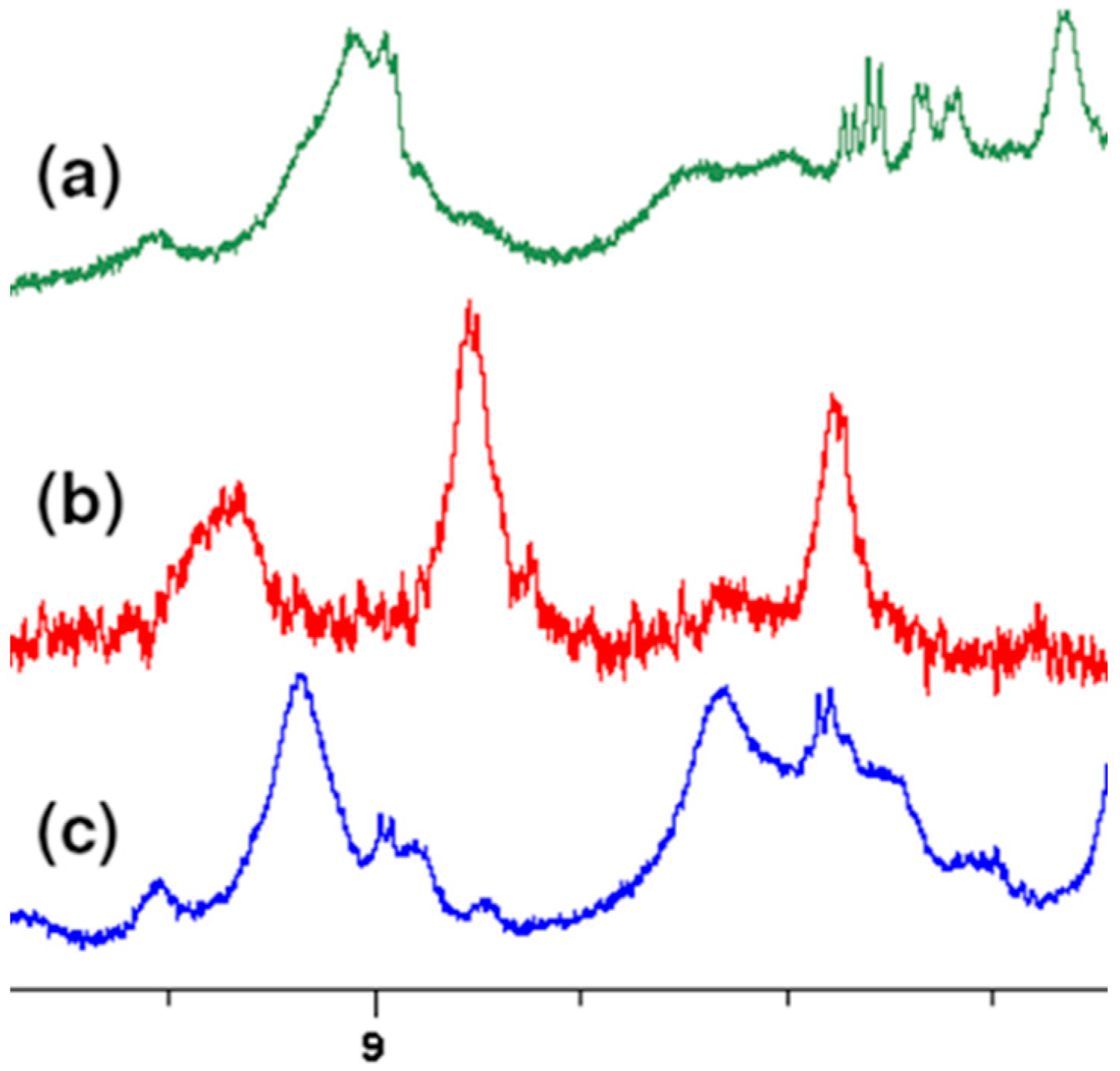
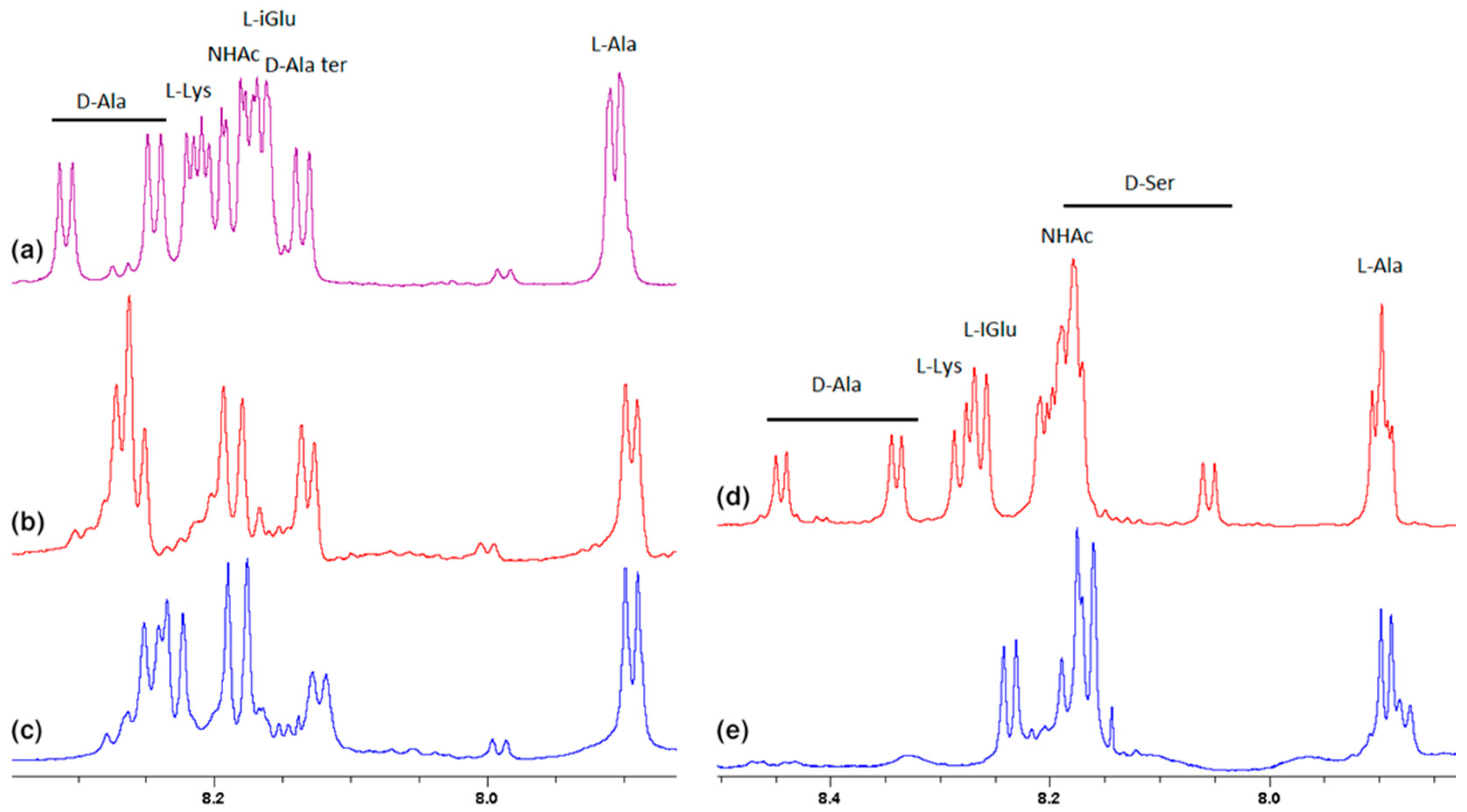

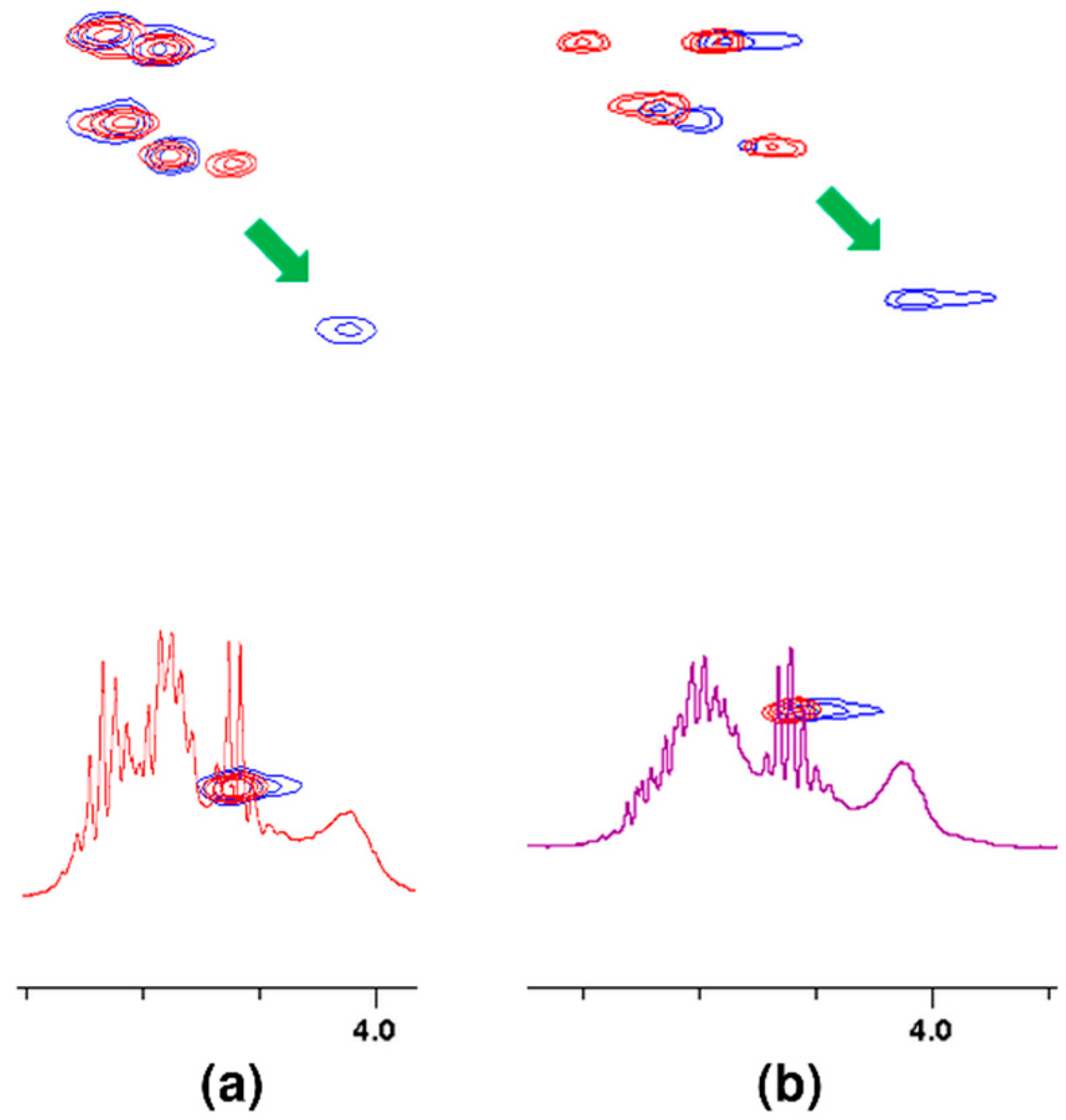
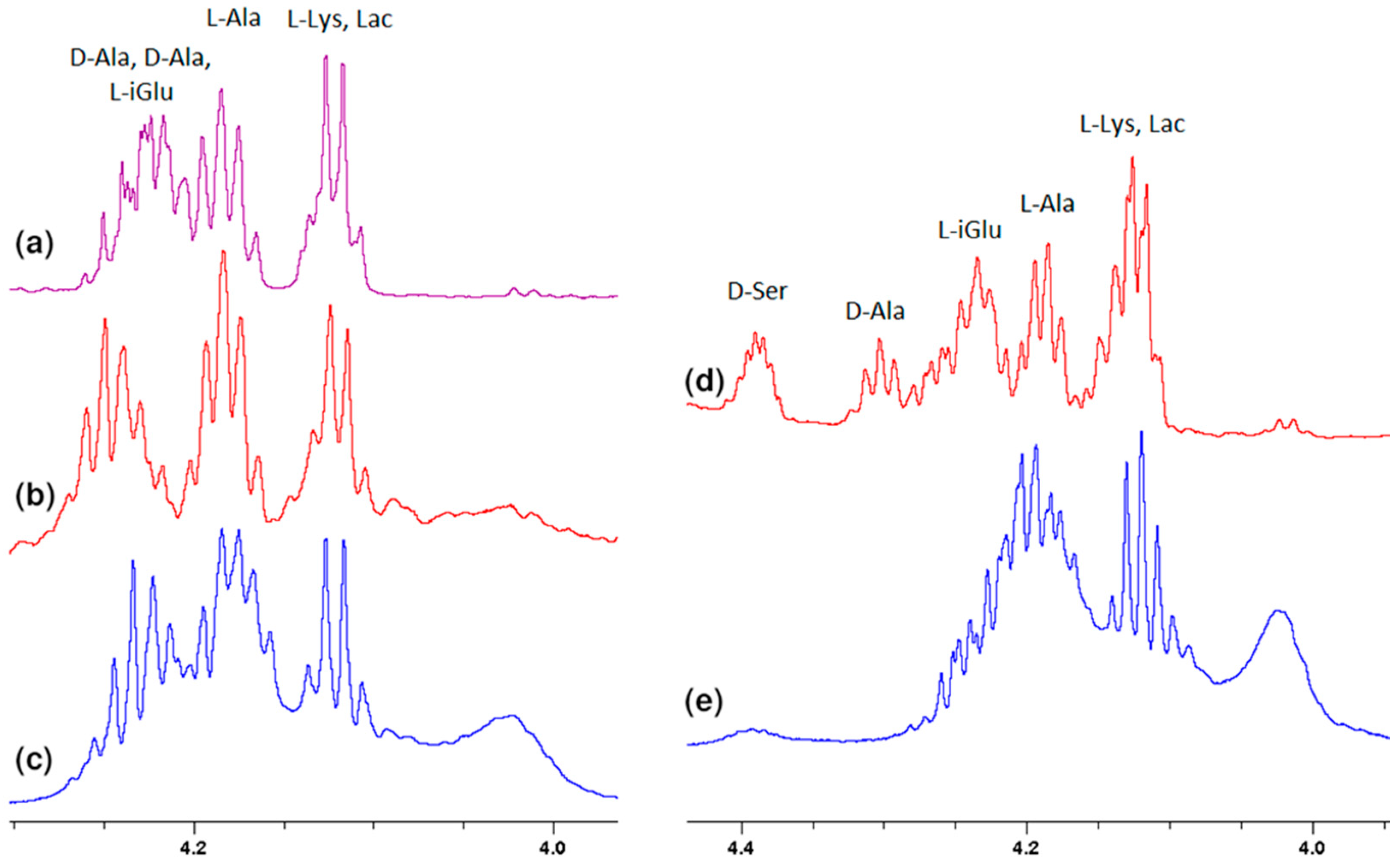
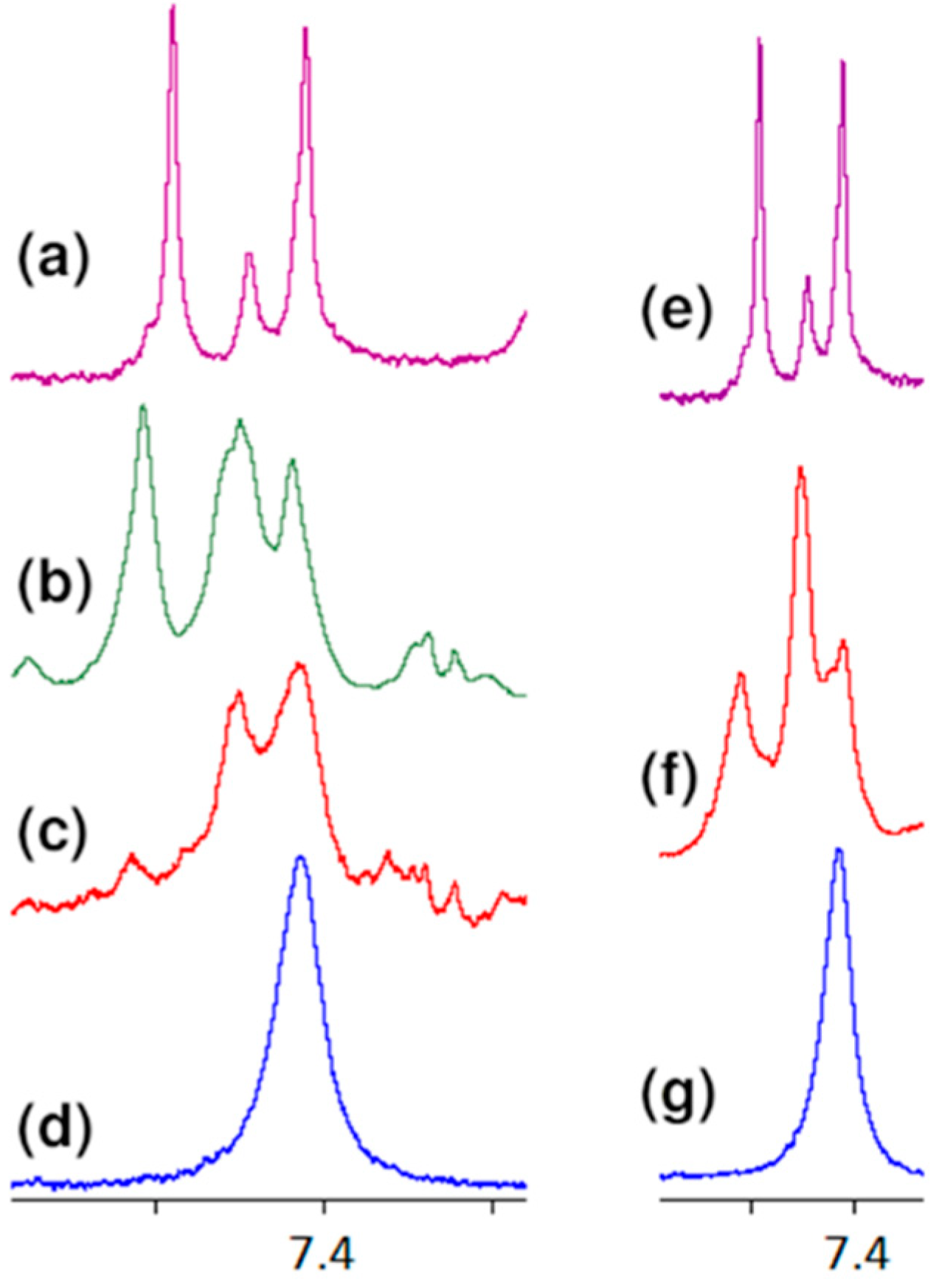
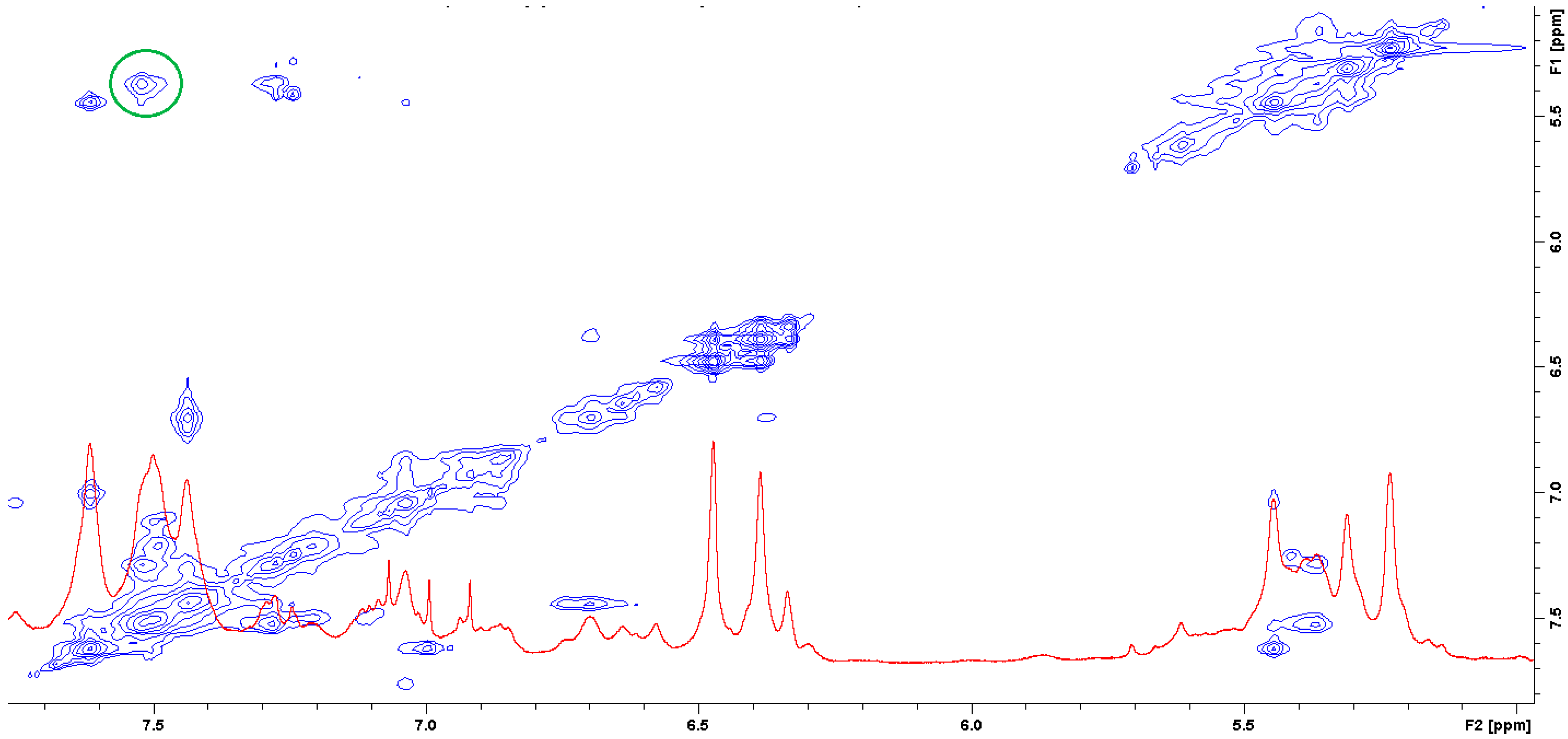
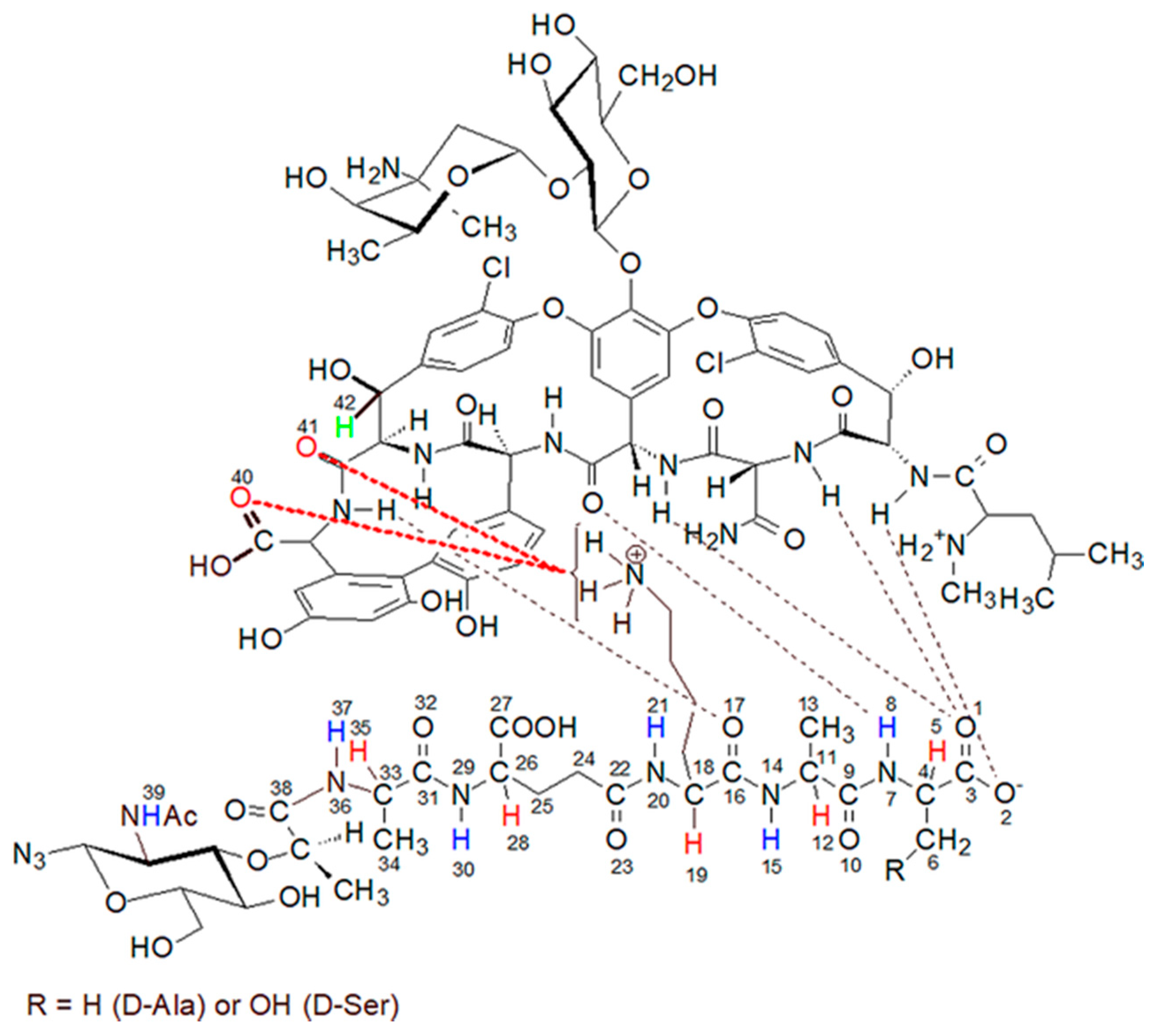
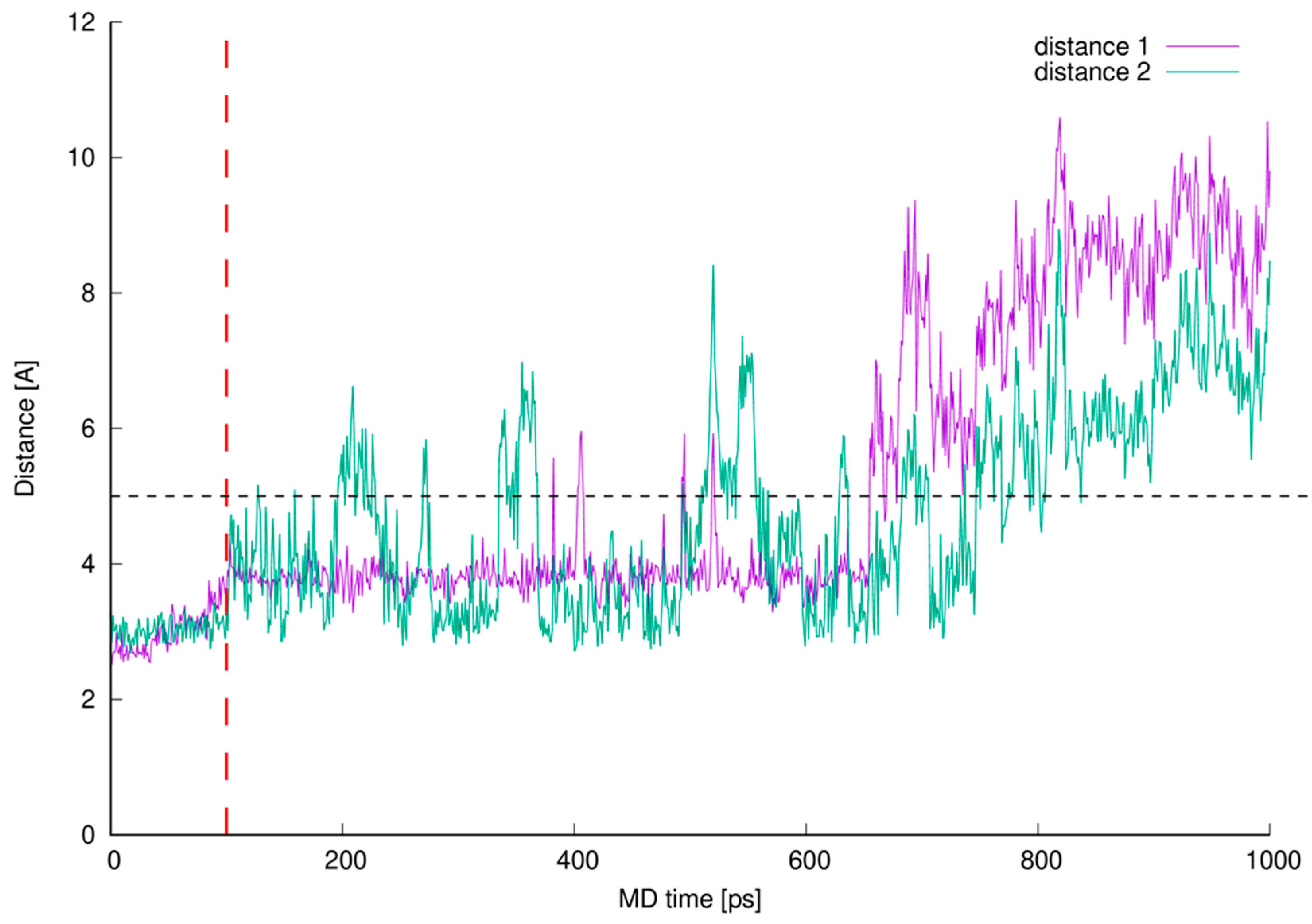
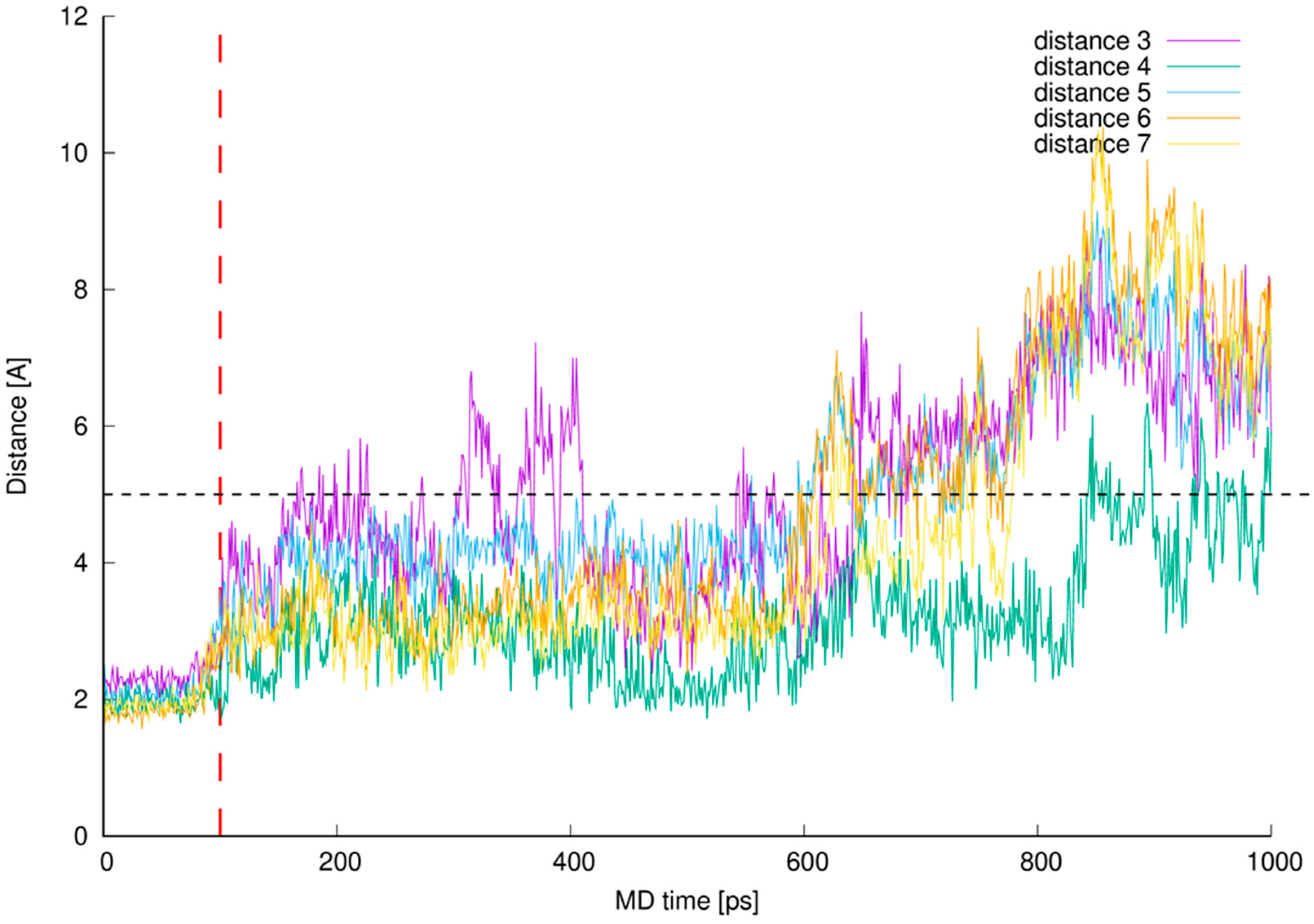

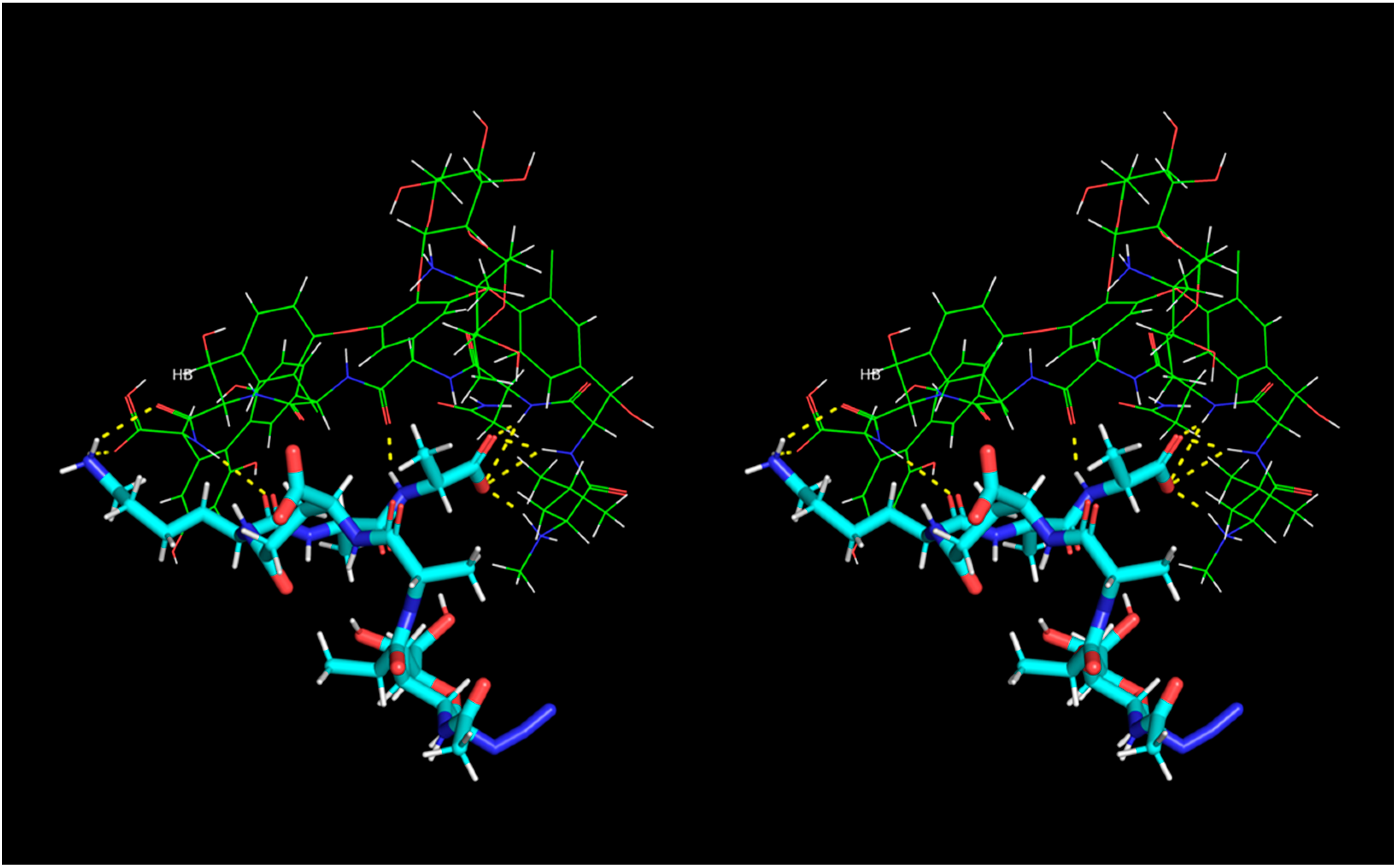
Publisher’s Note: MDPI stays neutral with regard to jurisdictional claims in published maps and institutional affiliations. |
© 2022 by the authors. Licensee MDPI, Basel, Switzerland. This article is an open access article distributed under the terms and conditions of the Creative Commons Attribution (CC BY) license (https://creativecommons.org/licenses/by/4.0/).
Share and Cite
Ślusarz, R.; Dmochowska, B.; Samaszko-Fiertek, J.; Brzozowski, K.; Madaj, J. NMR and MD Analysis of the Bonding Interaction of Vancomycin with Muramyl Pentapeptide. Int. J. Mol. Sci. 2022, 23, 1146. https://doi.org/10.3390/ijms23031146
Ślusarz R, Dmochowska B, Samaszko-Fiertek J, Brzozowski K, Madaj J. NMR and MD Analysis of the Bonding Interaction of Vancomycin with Muramyl Pentapeptide. International Journal of Molecular Sciences. 2022; 23(3):1146. https://doi.org/10.3390/ijms23031146
Chicago/Turabian StyleŚlusarz, Rafał, Barbara Dmochowska, Justyna Samaszko-Fiertek, Krzysztof Brzozowski, and Janusz Madaj. 2022. "NMR and MD Analysis of the Bonding Interaction of Vancomycin with Muramyl Pentapeptide" International Journal of Molecular Sciences 23, no. 3: 1146. https://doi.org/10.3390/ijms23031146
APA StyleŚlusarz, R., Dmochowska, B., Samaszko-Fiertek, J., Brzozowski, K., & Madaj, J. (2022). NMR and MD Analysis of the Bonding Interaction of Vancomycin with Muramyl Pentapeptide. International Journal of Molecular Sciences, 23(3), 1146. https://doi.org/10.3390/ijms23031146






